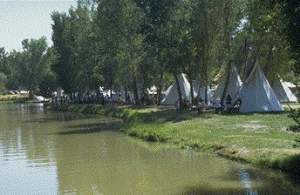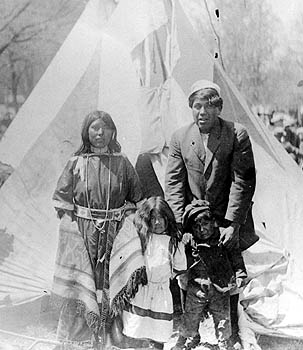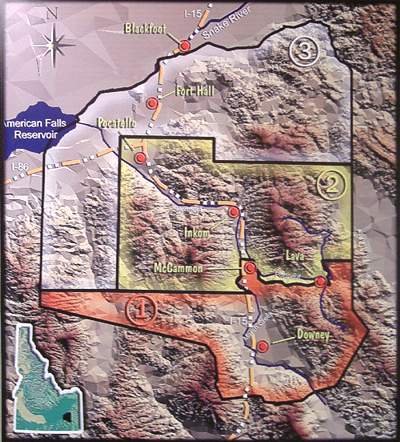Fort Buenaventura Project
Students will research topics in
the history and culture of the Northwestern Shoshone for the docent training
manual. The research should be presented as encyclopedic entries (2-3 pages)
with bibliography cited in
Turabian style.

Fort Buenaventura was the first permanent Anglo settlement in the Great
Basin. It marked the close of the exploration, trapping and trading era in the
West. The fort was originally established by Miles Goodyear in the early
1840s.
The fort has been reconstructed on a 32-acre tract of land in Ogden, 35 miles
north of Salt Lake City. Fort Buenaventura State Park includes stockade and
cabin replicas on the original site, visitor center, group camping and day-use
area, picnic tables, canoe rentals and modern rest rooms. Mountain men
activities are held as special times throughout the spring and summer.
Fort Buenaventura is now a Weber County Park:
http://www.co.weber.ut.us/parks/buenaventura/
Brock Cheney is the director:
bcheney@co.weber.ut.us
take the quiz for Utah History:
http://www.lessonquest.com/socialstudies/utah/1844.html

A
Shoshone family from Washakie photographed in Logan, Utah, May 6, 1909.
A short history of the Northwestern Shoshone by Mae Perry:
http://historytogo.utah.gov/nwshoshone.html
Information about the Northwestern Band of Shoshone:
http://dced.utah.gov/indian/shoshoni.html
Northwestern Bands of Shoshone vs. United States (1944):
http://www.utulsa.edu/law/classes/rice/USSCT_Cases/NW_Bands_Shoshone_v_US_324_335.htm

#1- On February 23, 1889, Congress finally
ratified the measure of Marsh Valley including 297,000 acres of the southern
portion of reservation land.
#2- On June 5, 1900, Congress ratifies the
Pocatello Cession Agreement; consisting of approximately 150,000 acres be sold
and "surplus" lands to be opened for settlement located at the southern end of
the reservation.
#3- the present day map of the Fort Hall Indian
Reservation; consists o f 544,000 acres remaining from the original Treaty of
1868; home to the Shoshone-Bannock people (including descendents of the Lemhi,
Weiser, Boise Valley, Bruneau Shoshoni, and the Northwestern Band of Shoshone
Nation).
Shoshoni Research Topics
MOCCASIN STYLES: Work from existing specimens and
diary entries to summarize moccasin styles and patterns among the Shoshoni and
other Utah Indians prior to 1870. Traits such as pucker toe vs. side seam, hard
sole, red wool, bead and/or quill work, etc. should be noted.
DECORATIVE MOTIFS: Work from existing specimens
to summarize decorative motifs used prior to 1870 in a variety of applications
from clothing and moccasins to tipi covers and parfleche.
ARCHITECTURAL TYPES: Work from photographs, diary
entries, and oral history to describe architectural types and construction
methods within Shoshoni groups, particularly detailing tipi, wickiup, sweat
lodge, shade arbor, and grass-mat shelters. Perhaps a 2 page paper on each?
Attach photos of each.
GAMES: Work from anthropological papers, diary
entries, and oral histories to describe games and pastimes among Shoshoni people
prior to 1870.
SUMMARY OF WATERMARK EVENTS: Write a brief 2-page
paper to summarize watermark events in Shoshoni history, such as the Bear River
Massacre; the establishment of the town of Washakie; abandonment of Washakie;
pivotal Crow-Shoshoni battles; etc.
SUMMARY OF HISTORICAL FIGURES: Write a brief
2-page paper to illustrate the contributions of important historical figures,
such as Washakie, Sagwich, Willie Ottogary, etc.?
SUMMARY OF THEMES IN ORAL TRADITIONS: Working
from Shoshoni Tales by Ann Smith, summarize themes in Shoshoni oral
traditions.
IDENTIFY ELEMENTS OF RELIGION: Working from
anthropological papers and oral history, identify elements of religion as
manifest in pipe ceremonies, sweat lodge ceremonies, story telling traditions,
hunting traditions, folk belief, etc.
MENíS CLOTHING: Working from art and photographs
pre-1870, describe menís clothing among the Shoshoni. Attach reproductions of
photos and art works.
OTHERS?


